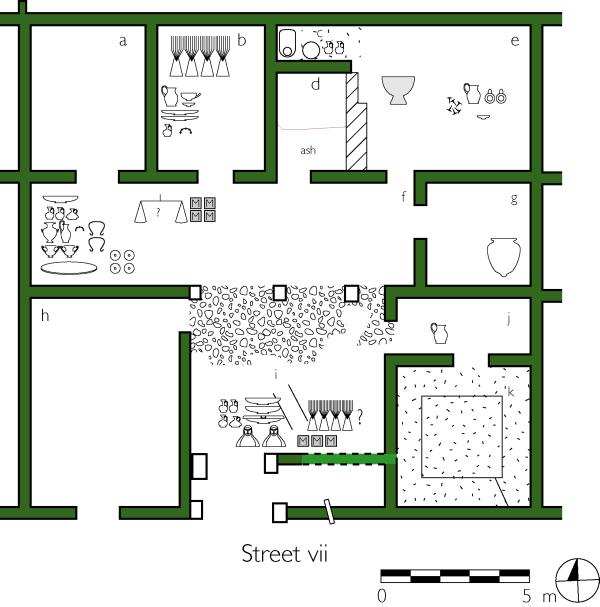
House A vii 4
Because of its regular plan, House A vii 4 has been used by many historians as the closest example to the prototypical Olynthian home 1. Rooms excavated here include the courtyard, pastas, kitchen, andron, anteroom, storeroom, and shop 7. Similar to the House of Many Colors in size (House A vii 4 is 17 m square) and division of space, House A vii 4 distinguishes itself because it contains a shop, uses distinct rooms in a more homogenous way, and depends more on the courtyard 1.
Rooms
Courtyard
The House A vii 4 courtyard is larger (7x6.2 m) and apparently more used than the one in The House of Many Colors 1,7. The courtyard is cobblestone and has a drain in the center, which led to the street 2. This particular court did not have an altar, though some did 2. It appears that this is the locus of domestic activity: sixteen loomweights, bronze weights, vases, ampstaind, lekythoi, and female protomes were excavated here1.
Pastas (f)
The pastas was to the north of the court and appeared to be used for storage of eating and drinking equipment and for work. The supporting wooden posts of the pastas also served as a screen between it and the court, since they were essentially open areas 2. Findings here include eating and drinking equipment (including bowls, hydria, and lekythoi), bronze bosses, jewelry, weights, components of a scale, and a table top (.42 m diameter). Interestingly, a very similar table top was found in suite a,b of the House of Many Colors 1.
North Rooms (a,b)
The nearly identical north rooms were apparently used for a variety of different purposes including weaving and storage. Unfortunately evidence in these locations was sparse: in room a, archaeologists found one coin. Room b contained loomweights, eating and drinking equipment, jewelry, a cylindrical lead bar, and terracotta figurines.
Kitchen Complex
Like the north rooms, little was excavated in the kitchen complex. It is clear, however, that the larger room was used for food processing; a mortar was found here, along with nails from a destroyed piece of furniture, lamps, tableware, and coins. Ash was found in the flue, suggesting that this area was used for cooking. A cutout in the floor indicates that there was also a bathtub here 7.
Storeroom
As in The House of Many Colors, there was also a pithos in the A vii. 4 storeroom. This pithos was significantly smaller, holding a mere 190 liters1.
Andron and Anteroom
The anteroom led into the andron, which is average size (4.4 x 4.5 m). The andron and anteroom were the only rooms in this home that were painted: the anteroom had yellow walls with a red band at the top and a black baseboard, while the andron had red walls with a yellow band, white baseboard, and a bight yellow platform around the perimeter of the room 2. Occasionally, the floors of the anteroom and andron were covered in geometric or mythological designs 2. The only recovery here was a pelike in the anteroom.1
Shop (h)
The shop, located in the southwest corner of House A vii 4, was publicly accessible through doors to the courtyard and the street 1. In the shop were found coins, a lekythos, saucer, bronze swinging handle in the wall, loomweights, and hardware. Weights and scales found in the pastas and courtyard reveal that shop work was also performed in other areas of the home. It is unknown what the owners of this home were selling 1.
QuickTime VR by Nick Cahill, May 2002
Copyright notice.